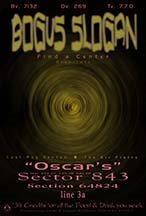No one here, gets out alive
In a Bogus Slogan poster, I used a radial blur filter that took my Mac Dual-core 2GHz PowerPC G5 processor over an hour to complete at 100% usage on both cores (27" x 40" @ 300 dpi). At the same time I was watching TV on a second monitor and surfing the internet, with the Mac OS polling the email server every 15 minutes. The amount of computer processing had to be incredible. In the first few seconds, my system probably surpassed one of the original computers, the ENIVAC of the 1940's.
 It certainly left my original Apple II in the dust. A 6502 cpu running at a snail's pace. I was very loathed to leave that simple world behind; especially since I had been able to program in assembly (machine) language. But, Apple EOL'd (end of line) the II. I continued to use an Apple IIe, even buying a replacement from a friend when my original motherboard failed. But then I saw the bouncing ball of the Amiga 1000. I know now, I wasted my money, but that machine was fun.
It certainly left my original Apple II in the dust. A 6502 cpu running at a snail's pace. I was very loathed to leave that simple world behind; especially since I had been able to program in assembly (machine) language. But, Apple EOL'd (end of line) the II. I continued to use an Apple IIe, even buying a replacement from a friend when my original motherboard failed. But then I saw the bouncing ball of the Amiga 1000. I know now, I wasted my money, but that machine was fun. The Amiga also introduced me to a couple of professional programmers writing ada code for the Department of Defense. They introduced me to Q, their roommate who was writing games in 6502 assembly. Q ( David Van Brink) wrote the Tempest arcade game look-a-like "Tubeway." His second game, "Ankh (64 Rooms)," was released just as the game distributor, Datamost, went bankrupt.

Q, coded his games using only a green screen 9" monitor. He did not have a printer. He wrote and debugged his source code on the screen using a special display code to indicate color.
My amazement was so sincere, that he gave me a copy of Ankh (on 5 1/4" floppy disk). It took me a week or two to solve all the puzzles, but that was just the start. Also on that disk were his source code and the editors for creating the elements of the game. I tried to return the software, but Q said don't worry about it. So I wrote Ankh 2.
ANKH's Lobby (64 rooms)

